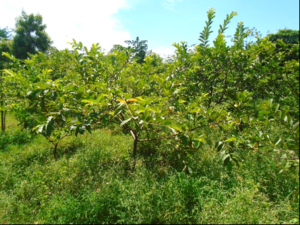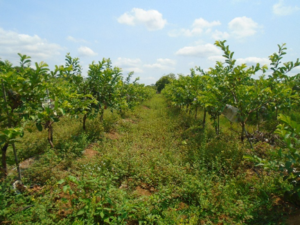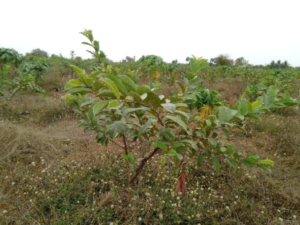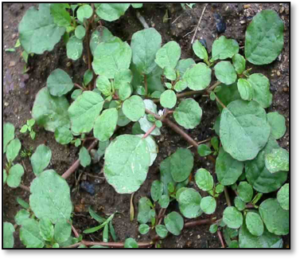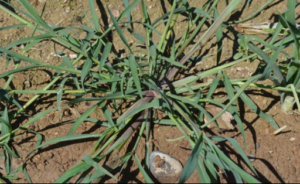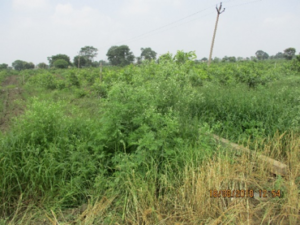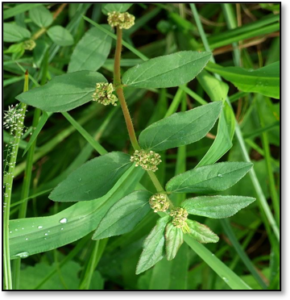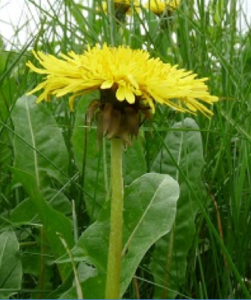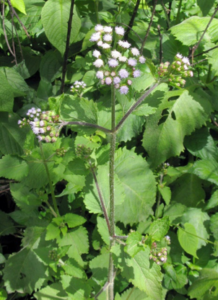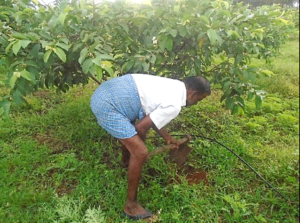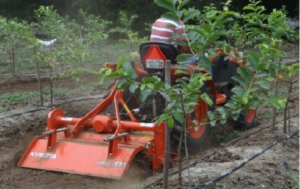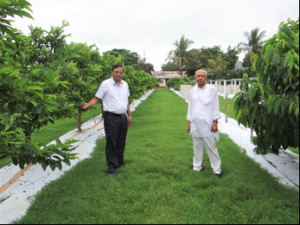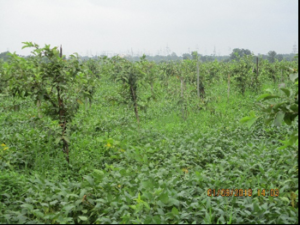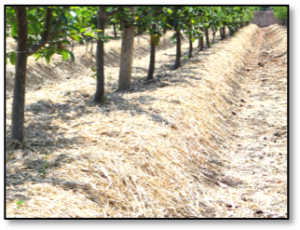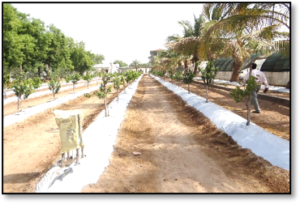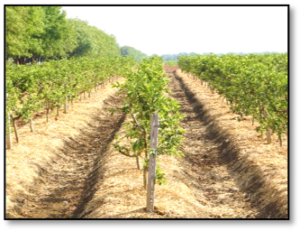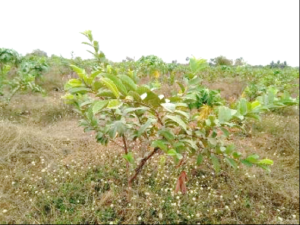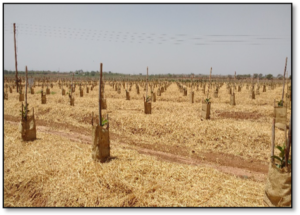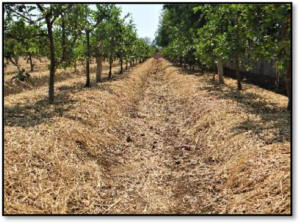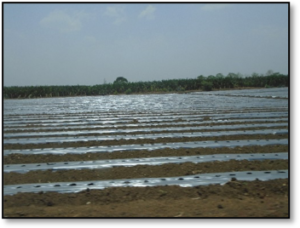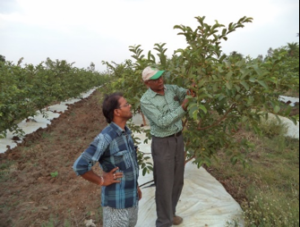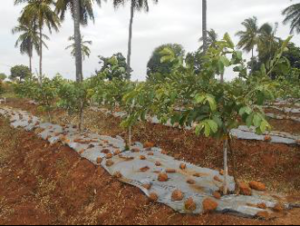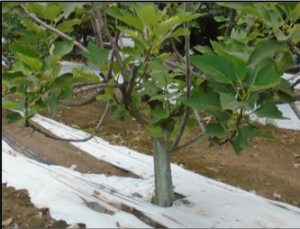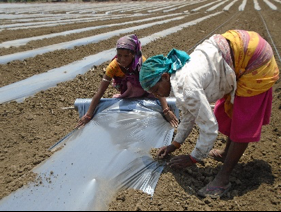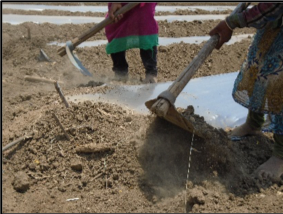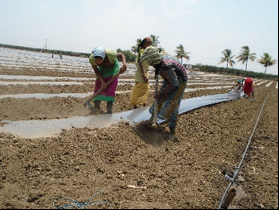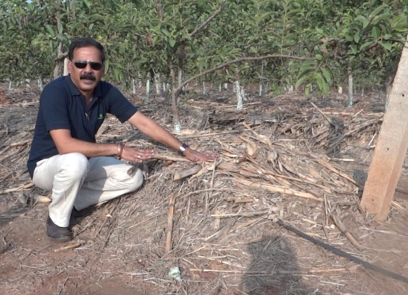What is a weed?
-Weeds are those undesirable plants i.e. sedges, grasses, aquatic plants, trees and parasitic flowering plants affecting cropped and non- cropped area.
Alternate Definitions:
-Weeds are unwanted and harmful plants which interfere with agricultural operations, increase labour, add to the cost of cultivation and reduce yield of crops.
-Anything that grows apart from our main crop in an orchard is known as weeds.
How can weeds enter an orchard?
- Dispersal by wind, birds, humans, animals etc.
- Allowing weeds to complete their life cycle with development of seeds for next generation
- Application of undecomposed Farm Yield Manure (FYM) containing weed seeds as a result of grazing
- Replacement of soil from another area for levelling of orchards
- Dry weeds with flower or seeds used as Organic Mulch
- Weed seeds in planting material from nurseries
How does weed affect the main crop?
Weeds mainly compete for nutrients, moisture, light and space which are the principle factors in any crop production.
- Reduction in initial plant growth
- Reduction in crop yield
- Loss in crop quality
- Interference in crop handling. i.e. movements of farm machinery, cultural practices and loss of human efficiency as fertilizer application, insect and disease control measures, irrigation, harvesting etc.
- In addition of these weeds also act as reservoirs for insect pests and diseases which also affect our crop time to time
An Orchard full of weeds
Identification of weeds in an orchard
One should be well acquainted with the identification of weeds as it will guide to effective an efficient control over it. Occurrence of weeds in an orchard mainly depends upon season, locality and life span of weeds.
I. Based on life span
Based on life span weeds are classified as Annual weeds, Biennial weeds and Perennial weeds
A. Annual Weeds
Weeds that live only for a season or a year and complete their life cycle in that season or year. These are small herbs with shallow roots and weak stems. Produces seeds in profusion and the mode of propagation is commonly through seeds.
Portulaca
B. Biennial weeds
Weeds those complete the vegetative growth in the first season, flower and set seeds in the succeeding season and then die. These are found mainly in non-cropped areas.
Barnyard Grass
C. Perennial weeds
Perennials live for more than two years and may live almost indefinitely. They adapt to withstand adverse environmental conditions.
Parthenium hysterophorus
II. Based on ecological regions and seasons
Mains Weeds in Guava Orchards occurred during Rainy season
Euphorbia hirta
Mains Weeds in Guava Orchards occurred during winter and spring season
Taraxacum officinale, Dandelion
Mains Weeds in Guava Orchards occurred during summer season
Ageratum conyzoides (billygoat-weed, chick weed, goatweed, whiteweed)
Weed Control Practices in Orchards
1. How can we control Weed on sources
- Destroy the weed before developing seeds as they will be primary source for next generation.
- Apply fully decomposed/ well rotten FYM because it may contain some weed seed.
- Deep ploughing of orchard during summer season for exposing of weed seeds to hot climate.
- Soil used form other locality for new orchard should be solarized prior to use.
- During application of biological mulch we have to insure that it should be free from weed seeds.
2. Hand weeding
In the early days of plantation or in the young orchard, it is always beneficial to remove weeds manually. Usually, a small hand tools (khoorpi) is used for removing weeds in basins of plant and between rows. This method of weeding is highly fruitful in small orchards, as usage of chemical may affect the young seedlings/plants.
3. Mechanical method
As orchard grows in age, it requires more inputs and power. Depending upon the spacing of the row, tractor mounted implements and tillers with special weeding tools attachments can be used to eradicate weed in orchard.
4. Cover cropping
Cover cropping is another practice followed in an orchard to suppress the growth of weeds, soil erosion and improve the health of soil. Plants which are compatible in terms of nutritional requirement, pest and disease management and which add advantage to the main crop are planted in between the rows as cover crop.
It also adds an advantage of maintaining micro climate of the orchard floor.
For minimizing weed growth:
Cynodon dactylon used as orchard floor
Soyabean as a cover crop
5. Chemical control
Chemicals used to eradicate, supress or hinder the growth of unwanted plants in an orchard are termed as herbicide or weedicide. As chemical are hazardous for both human and environment so it require a judicial use during its application.
6. Mulching
Any material which is used to cover the soil surface for prevention of moisture loss from the soil and to hinder the growth of weeds in an agricultural farm/orchard is known as mulch.
Application of mulching also plays a vital role in suppressing weed growth in an orchard.
A Brief Study on Chemical control of Weeds
Classification of Herbicides
1 Based on Method of application
- Application on soil: These Herbicides acts through root system of a plants body and are applied directly on the soil. e.g. Fluchloralin,
- Application on Foliage/leaves: Herbicide primarily active on the plant foliage e.g. Glyphosate, Paraquat
2 Based on Mode of action
Selective herbicide: A herbicide is considered as selective when in a mixed growth of plant species, it kills some species without injuring the others.
Non-selective herbicide: It destroys majority of treated vegetation e.g. Paraquat
3 Based on Time of application
i) Pre – emergence
Herbicides which are applied before crop or weed emerges. E.g. Pendimethalin.
ii) Post – emergence
Herbicide applied after the emergence of crop or weed is referred as post-emergence application. When the weeds grow before the crop plants have emerged through the soil and are killed with a herbicide then it is called as early post-emergence e.g. Paraquat.
*One should always keep in mind that these weedicides can be fatal for the main plant, so precaution to be taken so that the chemical do not come in contact with the main plant.
4 Based On Action
Two Type of weedicide we can apply in the fruit orchards.
Contact weedicide: A weedicide which kills those plant parts with which it comes in direct contact. e.g. Paraquat @ 2 – 5ml/ litre (In case of Moderate to high weed Population). It should be avoided in young orchard. The periphery around the canopy to be manually de-weeded.
Systemic weedicide: A weedicide which tends to move from treated part to untreated areas through xylem / phloem tissues depending on the nature of its molecule killing the cell on its pathway. e.g Glyphosate @10 ml/ Litre (In case of huge weed Population).
N.B – Glyphosate is not to be used during initial days of orchard when the plants are young and small. The suckers from root stock will absorb the chemical resulting in negative effect to the main crop. Regarding the usage of Glyphosate one has to take care that during monsoon the feeder roots tends to come towards the upper soil profile and becomes active during the period.
Glyphosate being systemic in nature the absorption of the same will be higher due to rains so during that time the chemical can give the effect to the main guava plant. So, it is suggested to use glyphosate during dry period.
A case study reported from Durg district of Chhattisgarh showed that a mixture of Glyphosate + Metribuzin used during monsoon season led to total death of 2 years old Guava orchard.
Never use glyphosate in and around the plants canopy or near the stem at least 2-3 ft radius from the same.
Things to remember while spraying weedicides
- Use flat fan or flat jet nozzle for uniform distribution of weedicide in the orchard.
- Always use the recommended dose of the weedicide, provided on the label of the vessel containing it.
- Use clean water (contamination free).
- Spay should be done in calm weather, do not perform it in the strong windy day.
- Manual weed removal is to be done in young orchard. While one can use polythene sheets to protect the plant while spraying so that he chemical do not come in contact with the plant.
- Do not use weedicide in combination with pesticides and fungicides.
Disclaimer
We do not suggest mixing of two different herbicides. Please ensure the safety and end results of the same with experts from SAU’s, KVK’s, Agricultural Research stations etc.
Preventive ways to stop weeds to flourish in an orchard –
- Try to control weeds and its growth in non-cropped areas, near boundary walls – fences, drainage outlets etc.
- Source planting material from good rated nurseries.
- Always clean machineries after usage from different plots.
- Control measure has to be followed appropriately after proper identification.
Mulching
What is Mulch?
Any material which is used to cover the soil surface for prevention of moisture loss from the soil and to hinder the growth of weeds in an agricultural farm/orchard is known as mulch.
What is the Role of mulching in an orchard?
Mulching in other hand is one of the preventive way to control weed and its growth in an orchard.
Advantages of mulching
- Prevent weeds growth, saves on fertilisers and pesticides cost
- Increases moisture retention in soil by lowering down evaporation rate
- Maintains soil temperature
- Maintain soil structure.
- Adds organic matter to soil and improve soil health (organic mulch)
- Increases crop yield.
- Reduces requirement of scarce and expensive manpower, required for regular cleaning of weeds.
- Leads to better root development and cleaner cultivation.
An Orchard full of weeds
What type of material can be used as mulch?
Basically two type of material can be used for mulching
- Organic mulch 2- Inorganic or Plastic mulch
What is organic mulch?
When material like compost, manure, straw (crop stems and stalks), dry grass clippings, sawdust, dried leaves, and other left-over crop residues used for mulching is known as organic mulch.
It helps to add organic matter in soil by decomposing itself on orchard floor. The limitation with this is that it may contain weed seeds and also sometimes it act as harbour for insects and pests.
N.B – Do not use undried or fermented plant debris of standing crop as a mulch in the same orchard as it maybe act as a medium for transferring pest and diseases. Also do not heap the mulch over the stem, the stem area at least an inch of its radius should be kept open, so that the stem does not rot due to accumulation of water/ moisture.
What is inorganic / plastic mulch?
Different coloured plastic sheets like black, white, silver used for covering the soil surface is known as plastic mulch. Plastic mulch is easy to handle but costly, however these materials do not add nutrients to the soil or improve its structure, but will hinder the growth of weeds and helps to retain the moisture.
Some other material like newspaper or cardboard can also be used as mulch
What should be the mulch covered area and thickness of mulch?
Usually the area covered by mulch should be perpendicular to that of canopy of a plant or the size of the bed. The thickness however in case of organic mulch should be around 20-30cm thick while on the other hand if it is a plastic mulch than it should not be less than 100 micron thickness, covering the entire bed area of the plantation. As the bed area is also a working zone so the thickness of inorganic mulch will provide longer shelf life.
When to do mulching?
Mulches as discussed earlier has advantages like conservation of soil moisture, controlling soil temperature and hindering weed growth control so mulches put an advantage throughout the cultivation. However season specific usage of mulches can add advantage in various way. Organic mulches adds on benefit during hot summer months when the irrigation water are scares, while it gets decomposed readily during the following monsoon season adding up organic manure enriching the soil. While different coloured mulches have different benefits, for e.g if one is doing plantations during summer/ monsoon than its better to use white black mulch with white on top, while during winters one should use sliver on black mulch with silver on top (Mostly for sub-tropical regions – N. Indian conditions).
N.B
- Mulches should be replaced once it gets detoriated as it may lead to weed growth on undesired areas and make cultivation difficult.
- Drip laterals should always be placed beneath the mulches.
Things to remember
Mulches should be pressed properly so that it does not get blown away by high wind velocity (as shown below)

